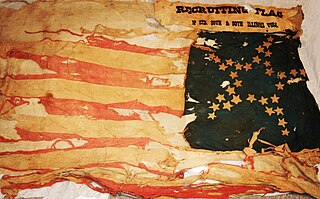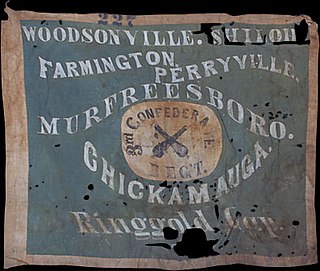| 5th Kentucky Infantry Regiment | |
|---|---|
| Active | October 21, 1861 – May 7, 1865 |
| Country | Confederate States of America |
| Branch | Confederate States Army Infantry & Mounted Infantry |
| Engagements | Battle of Ivy Mountain Battle of Middle Creek Battle of Princeton Battle of Chickamauga Atlanta Campaign Battle of Ringgold Gap Battle of Resaca Battle of Dallas Battle of Kennesaw Mountain Battle of Peachtree Creek Battle of Atlanta Battle of Jonesboro Sherman's March to the Sea |
The 5th Kentucky Infantry Regiment was an infantry regiment that served in the Confederate States Army during the American Civil War. In 1863 it became part of the First Kentucky Brigade.
The 5th Kentucky Infantry, initially recruited in Hager Hill, Kentucky, was organized October 21, 1861, at Prestonsburg, Kentucky and mustered in under the command of Colonel John Stuart Williams.
The regiment saw action in eastern Kentucky early in the war serving in the Army of Eastern Kentucky under Brig. Gen. Humphrey Marshall. On October 20, 1862, Marshall disbanded the regiment in a field just outside Hazel Green, Kentucky and gave the men three choices: honorable discharge, reenlist in the new regiment, or transfer to one of the cavalry regiments. In May 1863, command of the army passed to Brig. Gen. William Preston and was moved to Knoxville, Tennessee, becoming a division in Lt. Gen. Simon B. Buckner's Army of Tennessee.
Following the Battle of Chickamauga, the 5th Kentucky Infantry was transferred to the First Kentucky Brigade, remaining in that organization until the end of the war. The First Kentucky Brigade became part of the Atlanta Campaign on May 7, 1864, when they left their winter camps at Dalton, Georgia and took up positions on Rocky Face Ridge. The regiment became part of the fighting retreating force as Maj. Gen. William T. Sherman pushed the Confederates further back toward Atlanta. At the Battle of Dallas near New Hope Church, the First Kentucky Brigade made an unsupported charge, losing 51% of its strength. At the Battle of Jonesboro on August 31, 1864, the brigade was ordered to attack the entrenched federal position. At an unseen deep ravine, the attack came to a halt. The following day, the Confederates were overwhelmed when two-thirds of a Union Army division attacked and began to surround their positions. Many of the men of the 2nd Kentucky Infantry, 6th Kentucky Infantry, and 9th Kentucky Infantry were captured. The remnants of the brigade fell back and managed a successful defense against the Union assault, bringing it to a halt. On September 4, only 500 men were present for duty in the entire First Kentucky Brigade. That same month, the regiment was converted to mounted infantry.
The regiment was engaged in delaying tactics during Sherman's March to the Sea, following him all the way to Savannah, Georgia, finally moving to Augusta, Georgia, in early 1865. The regiment's last engagement was on April 29, 1865, in a skirmish near Stateburg, South Carolina. The regiment was ordered to Washington, Georgia and surrendered on May 7, 1865.

The Battle of Resaca was part of the Atlanta Campaign of the American Civil War. The battle was waged in both Gordon and Whitfield counties, Georgia, May 13–15, 1864. It ended inconclusively with the Confederate Army retreating. The engagement was fought between the Military Division of the Mississippi on the side of the Union and the Army of Tennessee for the Confederates.

The Battle of Kennesaw Mountain was fought on June 27, 1864, during the Atlanta Campaign of the American Civil War. It was the most significant frontal assault launched by Union Maj. Gen. William T. Sherman against the Confederate Army of Tennessee under Gen. Joseph E. Johnston, ending in a tactical defeat for the Union forces. Strategically, however, the battle failed to deliver the result that the Confederacy desperately needed—namely a halt to Sherman's advance on Atlanta.

Alfred Iverson Jr. was a lawyer, an officer in the Mexican–American War, a U.S. Army cavalry officer, and a Confederate general in the American Civil War. He served in the 1862–63 campaigns of the Army of Northern Virginia as a regimental and later brigade commander. His career was fatally damaged by a disastrous infantry assault at the first day of the Battle of Gettysburg. General Robert E. Lee removed Iverson from his army and sent him to cavalry duty in Georgia. During the Atlanta Campaign, he achieved a notable success in a cavalry action near Macon, Georgia, capturing Union Army Maj. Gen. George Stoneman and hundreds of his men.

The Battle of Tupelo was a battle of the American Civil War fought from July 14 to 15, 1864, near Tupelo, Mississippi. The Union victory over Confederate forces in northeast Mississippi ensured the safety of Sherman's supply lines during the Atlanta Campaign.

The Orphan Brigade was the nickname of the First Kentucky Brigade, a group of military units recruited from Kentucky to fight for the Confederate States of America during the American Civil War. The brigade was the largest Confederate unit to be recruited from Kentucky during the war. Its original commander was John C. Breckinridge, former United States Vice President and candidate for president, who was enormously popular with Kentuckians.
The Battle of Griswoldville was the first battle of Sherman's March to the Sea, fought November 22, 1864, during the American Civil War. A Union Army brigade under Brig. Gen. Charles C. Walcutt fought three brigades of Georgia militia under Brig. Gen. Pleasant J. Philips, at Griswoldville, near Macon, Georgia, and continued its march toward Savannah.

William Wirt Adams was a banker, planter, slave-owner, state legislator, and Brigadier-General in the Confederate States Army.

The 80th Illinois Volunteer Infantry Regiment was an infantry regiment that served in the Union Army during the American Civil War. The regiment was composed of ten companies that drew primarily from eight southern Illinois counties. Over the course of the war the regiment traveled approximately 6,000 miles, and was in over 20 battles.
The 2nd Kentucky Infantry Regiment was an infantry regiment that served in the Confederate States Army during the American Civil War. It was part of the First Kentucky Brigade.

1st Arkansas Mounted Rifles (1861–1865) was a Confederate Army cavalry regiment during the American Civil War. The unit was formed as a mounted infantry regiment, but was dismounted in the spring of 1862 and remained dismounted for the remainder of the war. The unit participated in the earliest battles in the western theater at Wilson's Creek and surrendered with the remnants of the Army of Tennessee in North Carolina in April 1865.

Ezra Ayers Carman was an officer in the Union Army during the American Civil War, commanding a New Jersey infantry regiment and (occasionally) a brigade.

Charles Garrison Harker was a brigadier general in the Union Army during the American Civil War. He was killed in action at the Battle of Kennesaw Mountain in northern Georgia during the Atlanta Campaign. Fort Harker in Kansas, an active garrison of the United States Army from 1866 to 1872, was named in his honor.

John King Jackson was an American lawyer and soldier. He served as a Confederate general during the American Civil War, mainly in Florida and the Western Theater of the conflict. Afterward Jackson resumed his law practice until dying from pneumonia a year after the war ended.
The 3rd Kentucky Infantry Regiment was a volunteer infantry regiment that served in the Confederate States Army during the American Civil War. It was part of the First Kentucky Brigade through August 1862.

The 4th Kentucky Infantry Regiment was an infantry regiment that served in the Confederate States Army during the American Civil War. It was part of the First Kentucky Brigade.
The 6th Kentucky Infantry Regiment was an infantry regiment that served in the Confederate States Army during the American Civil War. It was formed from Nelson, Barren, and surrounding counties. It was also part of the First Kentucky Brigade.
The 7th Kentucky Infantry Regiment was an infantry regiment that served in the Confederate States Army during the American Civil War.
The 8th Kentucky Infantry Regiment was an infantry regiment that served in the Confederate States Army during the American Civil War.
The 9th Kentucky Infantry Regiment was an infantry regiment that served in the Confederate States Army during the American Civil War. It was part of the First Kentucky Brigade.

The 18th Arkansas Infantry (Marmaduke's) (1861–1865) was a Confederate Army infantry regiment during the American Civil War. The unit was also briefly identified as the 1st Arkansas Infantry Battalion. The unit was most often referred to as the 3rd Confederate Infantry Regiment. The designation "Confederate Infantry Regiment" was intended to convey the difference between Provisional Confederate Army units and Regular Confederate Army Units, with Provisional units being those regiments who received a state designation such as "XX Arkansas Infantry Regiment". In practice, the designation was most often utilized when Regiments were assembled utilizing companies from more than one confederate state. The "3rd Confederate Infantry Regiment" is occasionally misidentified as the 3rd Arkansas Infantry Regiment commanded by Colonel Van H. Manning.